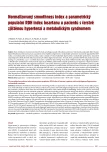Is our management of patients with claudicatio intermittens correct?
Authors:
V. Štvrtinová
Authors‘ workplace:
II. interná klinika Lekárskej fakulty UK a FNsP Bratislava, Slovenská republika, prednosta prof. MU Dr. Andrej Dukát, CSc., FESC
Published in:
Vnitř Lék 2010; 56(9): 1005-1009
Category:
60th Birthday - Andrej Dukat MD, Csc., FESC
Overview
Claudicatio intermittens is the major symptom of peripheral arterial disease of extremities. At the same time it is an important manifestation of systemic atherosclerosis. In spite of the fact that the diagnosis of claudicatio intermittens requires only simple, non‑invasive, and inexpensive diagnostic methods, the disease is still underdiagnosed and often goes untreated. Proper treatment of patients with claudicatio intermittens prevents the progression of the disease and development of critical limb ischemia as well as reduces other complications of systemic atherosclerosis, including cardiovascular death.
Key words:
claudicatio intermittens – diagnosis – treatment
Sources
1. Charcot JM. Sur la claudication intermittente observée dans un cas d’oblitération complete de l’une des arteres iliaques primitives. Comptes rend Soc Biol (Paris) 1858; 12: 225.
2. Bouley JF. Claudication intermittende des membres postérieurs, déterminée par l’oblitération des arteres fémorales. Recueil de Méd Vét Prat 1831; 8: 517.
3. Fontaine R, Kim M, Kieny R. Die chirurgische Behandlung der peripheren Durchblutungsstörungen. Helv Chir Acta 1954; 5: 499– 533.
4. Puchmayer V, Roztočil K. Praktická angiologie. Praha: Triton 2003.
5. Andreozzi GM, Arosio E, Martini R et al. Consensus document on intermittent claudication from the Central European Vascular Forum 1st edition – Abano Terme (Italy) – May 2005 2nd revision – Portroz (Slovenia) September 2007. Int Angiol 2008; 27: 93– 113.
6. Rutherford RB, Baker JD, Ernst C et al. Recommended standards for reports dealing with lower limb extremity ischemia: revised version. J Vasc Surg 1997; 26: 517– 538.
7. Heidrich H, Wenk R, Hesse P. Frequency of asymptomatic peripheral arterial disease in patients entering the department of general and internal medicine of a general‑ care hospital. Vasa 2004; 33: 63– 67.
8. Diehm C, Schuster A, Allenberg JR et al. High prevalence of peripheral arterial disease and co‑ morbidity in 6880 primary care patients: cross‑ sectional study. Atherosclerosis 2004; 172: 95– 105.
9. Kolesár J, Dukát A, Gavorník P et al. Ischemická choroba dolných končatín vo vzorke populácie mužov nížinnej oblasti Slovenska. Fysiat Vestn 1985; 63: 158– 162.
10. Management of peripheral arterial disease (PAD). TransAtlantic Inter‑ Society Consenzus (TASC). Int Angiol 2000; 19 (Suppl 1): 1– 304.
11. CAPRIE steering committee. A randomized, blinded, trial of clopidogrel versus aspirin in patients at risk of ischaemic events (CAPRIE). Lancet 1996; 348: 1329– 1339.
12. Aronow WS, Ahn C. Prevalence of coexistence of coronary artery disease, peripheral arterial disease, and atherothrombotic brain infarction in men and women > or = 62 years of age. Am J Cardiol 1994; 74: 64– 65.
13. Taute BM, Thommes S, Taute R et al. Long‑term outcome of patients with mild intermittent claudication under secondary prevention. Vasa 2009; 38: 346– 355.
14. Štvrtinová V, Štvrtina S, Wsólová L et al. Prevalence of peripheral arterial disease in the Slovak republic. CEVJ 2009; 8: 32.
15. Štvrtinová V, Šefránek V, Murín J et al. Odporúčania pre diagnostiku a liečbu periférneho artériového ochorenia dolných končatín PAO DK. Vask Med 2010; 2 (Suppl 2): 1– 18.
16. Cachovan M. Ergometrie. In: Alexander K (ed). Alexander Gefässkrankenheiten. München, Wien, Baltimore: Urban a Schwarzenberg 1994: 142– 144.
17. Staněk F. Ischemická choroba dolních končetin (ICHDK) – chronické formy. In: Karetová D, Staněk F (eds). Angiologie pro praxi. Praha: Maxdorf 2001: 21– 75.
18. Petrovičová J, Štvrtinová V. Rehabilitácia a liečebný telocvik pri periférnych artériových obliterujúcich ochoreniach. In: Štvrtinová V (ed). Choroby ciev. Bratislava: SAP 2008: 250– 258.
19. Hiatt WR. Medical treatment of peripheral arterial disease and claudication. N Engl J Med 2001; 344: 1608– 1621.
20. Gavorník P, Holomáň M, Kolesár J et al. Kinezioterapia ischemickej choroby dolných končatín u chorých po rekonštrukčnej operácii tepien. Čas Lék Čes 1986; 125: 1000– 1003.
21. Štvrtinová V, Ambrózy E, Kriška M. Farmakoterapia PAO. In: Štvrtinová V (ed). Choroby ciev. Bratislava: SAP 2008: 229– 236.
22. Norgren L, Hiatt WR, Dormandy JA et al. Inter‑ Society Consensus for the Management of Peripheral Arterial Disease (TASC II). Eur J Vasc Endovasc Surg 2007; 33 (Suppl 1): S1– S75.
23. Hiatt WR. The US experience with cilostazol in treating intermittent claudication. Atherosclerosis 2005. Available from www.elsevier.com/ locate/ atherosclerosis.
24. Sugimoto I, Ohta T, Ishibashi H et al. Conservative treatment for patients with intermittent claudication. Int Angiol 2010; 29 (Suppl 2): 55– 60.
25. Mondillo S, Ballo P, Barbarati R et al. Effects of simvastatin on walking performance and symptoms of intermittent claudication in hypercholesterolemic patients with peripheral vascular disease. Am J Med 2003; 114: 359– 364.
26. Aronow WS, Nayak D, Woodworth Set al. Effect of simvastatin versus placebo on treadmill exercise time until the onset of intermittent claudication in older patients with peripheral arterial disease at six monthsand at one year after treatment. Am J Cardiol 2003; 92: 711– 712.
27. HPSCG. MRC/ BHF Heart Protection Study of cholesterol lowering with simvastatin in 20,536 high‑risk individuals: a randomised placebo‑ controlled trial. Lancet 2002; 360: 7– 22.
28. Abramson BL, Huckell V, Anand S et al. Canadian Cardiovascular Society Consensus Conference: peripheral arterial disease – executive summary. Can J Cardiol 2005; 21: 997– 1006.
Labels
Diabetology Endocrinology Internal medicineArticle was published in
Internal Medicine

2010 Issue 9
Most read in this issue
- Heart and kidneys – a fatal relationship
- Statin myopathy – rarity or reality?
- Our experience with endoscopic drainage of pancreatic pseudocysts
- Adrenal incidentalomas – is the present management rational?
